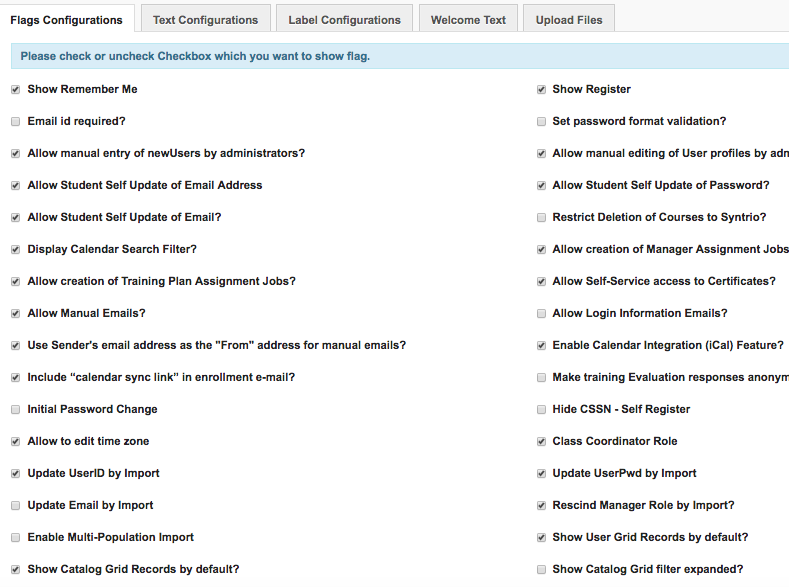0 Items - $0.00
- No products in the cart.
Search our knowledge base and articles, or submit a request.
LMS Configuration Options
There are a variety of configuration options that are available in the Syntrio LMS E10. Some of these are hidden from the panel and must be instituted by Syntrio Client Services, while some are available to you as System Administrator.
NOTE: Flag configurations are hidden from client view, and are instituted by Syntrio Client Services, in consultation with you as the client. Upon review, please contact Client Services.

Here is a listing of each Configurable Flag, and what it turns on or off:
Label Configurations are the personally identifying information, for each user. The label can be changed, to have more meaning for a site or organization.
At a minimum, this includes Unique ID, Login ID, Password, Email.
While not often used, the other labels can be changed for any necessary personal information that is necessary to capture, for training purposes. The full list:
This is the field where users can create the front-page message for the site, using a robust page creation editor.
Syntrio Learning Management System Onboarding
How to Access Your Outstanding Assignment to Launch Course
Updating the Front Page Message and Site Customization (Themes, Announcements)
Viewing the evaluations for a course, in the LMS
How to Print Multiple Certificates for a Course
How to Upload Documents to LMS, and then get the URL link to that document
How To Add A Course To The LMS
How To Access And Print A Certificate
How To Send A General Email from the LMS
How to Search and Update Records
How to Edit Course Data – Name, Code, Score, Description
How to manually provide a Completion Record for an online course
How to View or Delete A Training Record, or Training Plan Record for an Individual
Effective Reporting on LMS: Activity and No Activity
What is the best size for the logo for my site?
Direct Link to Course Launch, Upon Login
Reporting in LMS E10, an introduction
If emails are within the LMS, in an inbox, are they also sent to my email?
Checklist before launching the site
How can I set and view the different emails that come from the LMS?
What size can the announcements widget work with?
How can I tell in the LMS, what books or lending library items are checked out?
How do I find the administrator Guide or manual for Syntrio LMS E10?
Submit a Request and we will get back to you.